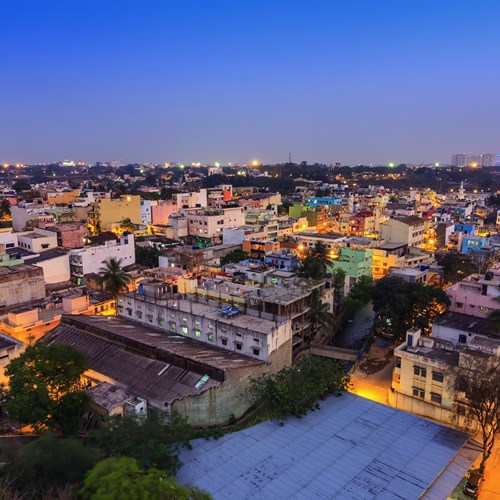
Bangalore, India
Once a sleepy regional capital, Bangalore today is a modern metropolis that will come as a big surprise to those who are visiting for the first time. Also known as Bengaluru, the capital of Karnataka is the technological hub of India and the very place where the country’s new, confident and global identity is being forged. Although the city might somewhat lack in historical sites, its buzzing and liberal atmosphere provides the perfect base for exploring the beautiful temples and palaces of the Deccan.
Population:
12.34 million (2017)
Currency:
1 Rupee (Rs.) = 100 Paise
Coins: 1, 2, 5, 10, 20, 50, 100, 500
Banknotes: 10, 20, 50, 100, 500
Note: 1, 2 and 5 are available in the form of both coins as well as notes.
Emergency Numbers:
Police: 100
Ambulance: 102
Fire Brigade:101
Opening Hours:
Shops are open from Mon-Sat 10am-12pm and 4pm-8pm, while restaurants and clubs have to close at 11.30pm. Banks operate Mon-Fri 10am-2pm and Sat 10am-12pm.
Newspapers:
Bangalore Mirror (in English)
DNA India (in English)
Deccan Chronicle (in English)
Economic Times (in English)
The Times of India (in English)
Vijay Karnataka (Regional new paper)
The City

Once known as 'The Garden City' of India, earliest records of a place named ’Bengaluru’ date back to a 9th century temple in an area that is now known as ’Old Bangalore’. And legends surround Bangalore: while one legend has it that Bengaluru (Town of Boiled Beans) got its name after an old woman served cooked pulses to a lost and hungry Hoysala king, another one has it that a feudal lord was hunting in the area when a rabbit turned and attacked his dog, and as this made a great impression on the lord, he gave the place the title of Gandu Bhoomi (the place of heroes).
Besides the magic atmosphere that old Indian traditions have created around the city, Bangalore is also a metropolitan hub, and constantly changing. Buildings rise up at a fast pace while a new city centre has come into the world, in a clutch of skyscrapers in the area surrounding Cubbon Park.
The city is split into two main districts: ’Urban’ and ’Rural’. Within the city itself, Mahatma Gandhi Road (M.G. Road), running from Trinity Circle at one end to Anil Kumble Circle at the other, is the main thoroughfare filled with banks, smart shops and restaurants. The city’s other main hub, Gandhinagar, in the western part of the city, is where you will find the central bus stand and the main railway station. Nicknamed “Majestic”, the area is crowded, busy and and full of shops, cinemas and budget hotels. In the northern part of the town reside the Raj-era buildings, the High Court and the racecourse. Bangalore Urban district contains the city itself and many of the main sights, and it is further divided into the North, South and also the Anekal districts, comprising more than 600 villages in total.
The Bangalore Rural district comprises 1,000 different villages and it is ideal if you fancy escaping from the chaos of the city life. Outside the city, Savandurga is a famous hilltop with temples dedicated to Gangadeshwara, Hanna Devi and a cave spring called Pattala, that – in a bull-shaped figure – has enchanted tourists for years.
Do & See

Despite Bangalore's sudden development, the city preserves its charm unaltered, in a plethora of old buildings, temples, colourful markets and peaceful gardens.
The extraordinary timber-built Tipu Sultan Palace in the heart of the city gives a fascinating glimpse into Bangalore's past, and a sense of perspective in this wannabe-modern city projected into the future. A renowned 17th-century temple and the ruins of Bangalore's fort are only a few steps away, creating a hub of historical constructions. Karnataka's State Legislature and Secretariat building, one of India’s greatest buildings, is located north-west of Cubbon Park.
Despite the rush of modern life, Bangalore has a strong religious tradition, so make sure to head to Bugle Hill and the Bull Temple. As a favourite among travellers, this breathtaking 16th-century construction literally dwarfs whoever passes by.
Bangalore is a city to be experienced and explored. The Garden City is famous for its parks, with some of them dating back over 200 years, and the most impressive ones are the botanical gardens of Lal Bagh.
Dining

Bangalore is a gourmand's paradise, as the local cuisine takes in influences from Andhra, Chettinad, Hyderabadi, Tamil, Mangalorean and Keralan dishes with a big emphasis on rice, sambar and rasam (vegetable stew and soup) dishes. As a global capital, Bangalore also offers a great variety of international cuisine but the real delight is to fully indulge in its delicious local cuisine, as there is something for everyone.
You should start the day with a plate of unbeatable masala dosa, a delicious crepe stuffed with spiced potatoes known as the “food of the gods”, accompanied by some chai tea. Lunch or dinner normally consists of steamed rice, curries, vegetable dishes and pickles, and one or two sweet dishes like poppadoms, buttermilk, curd and ghee. It is tradition to start the meal with a sweet dish and to finish it with curd rice, and everything is served on well-rinsed Banana leaf.
Cafes

With the emergence of a cosmopolitan cafe culture, new venues and fast food outlets pop up in Bangalore, and the high tea became a social event not only for the upper class but for everybody. While predictable café chain like Barista and Coffee Day soon settled, hip hangouts with DJs or live music as well as more traditional settings also rose up in the heart of the city, awaiting you for having a break.

